Excursions
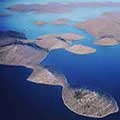
It was declared National park in 1980 and then it was placed under protection. The total area of the park is about 220 square kilometers and it consists of 89 islands, islets and rocks. Out of the park area, only about 1/4 is land, while the rest is a marine ecosystem. It abounds in natural and cultural features. The vertical cliffs of the "crown" of the Kornati islands facing the open sea are the most popular phenomenon of this park. They are also the habitat of rare species. The Kornati submarine world reveals some other amazing stories. And it is good to know that the terrestrial part of the Park is privately owned.
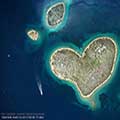
Galešnjak (Island of Love, Island for those in love) is located in the Pašman channel between the island of Pašman and the place Turanj. It became one of the world phenomena because it is heart-shaped. Its area is 0,132 km2. Napoleon's cartographer Charles-Francois-Beautemps-Beaupré was first to record its form in the early 19th century and in 1806 he included it in the atlas of the Dalmatian coast. On Google Earth the island was marked in February 2009.
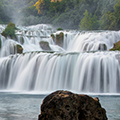
The Krka National Park is located in the area of the Šibenik – Knin County and it includes the most beautiful part of the river Krka flow and the lower river Čikola flow. With seven travertine waterfalls Krka is a natural and carst phenomenon. On the surface of 10,000 m2 (1 ha), of which more than 70% is in the shade of pine trees, a large number of caravans and tents (40 caravan units) can be accommodated. Each camp unit has access to electricity. There are also sanitary facilities at two locations. Within the park there is a children's playground and a bowling ground. The tourists have the possibility to buy fresh bread every day.
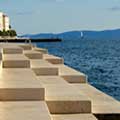
The stone stairs extend at about seventy meters of coastline, divided into seven ten-meter sections, below which, at the lowest sea tide level, vertically to the coast 35 polyethylene pipes of various lengths, diameter and slope are built in, which obliquely rise to the coastal paving and end in a canal (service corridor). The air pushed by a wave is led from the wider to the narrower profile, in order to gain acceleration and produce sound in pipes (LABIUMS - whistles) located in the corridor under the seafront promenade, from where the sound (through mystical openings in the stone) comes out into the space of the promenade. The instrument has seven clusters of five chosen tones derived from the matrix of the Dalmatian a capella singing. As the energy of the sea is unpredictable in countless modifications of the high tide, low tide, size, strength and direction, so the eternal sea organ concert is unique in countless musical variations, whose author and interpreter is the nature itself.
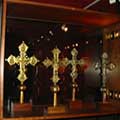
The exhibition "Gold and Silver of Zadar" which in 1951 was initiated by the Croatian writer Miroslav Krleža was transformed in 1976 in the Permanent exhibition of the church art within the Zadar Benedictine Convent of St. Mary, one of the first capital buildings of the Croatian culture. On the occasion of the exhibition Krleža wrote one of his best essays in which he glorifies the gold of Zadar. On about 1200 m2 of space in 8 modernly equipped halls the Zadar gold and silver shine beside the reconstructed interior of the tiny old-Croatian church of St. Nediljica from the 11th century, manuscripts, sculptures, embroidery, tapestry, reliefs etc, as evidence of the rich past of Zadar from the 8th to 18th century which particularly in the Middle Ages was a very important cultural center. Joys and hopes, patience, suffering and faith of the tumultuous eras of this region are wowen into the reliquaries and chalices, sculptures, paintings and embroidery.
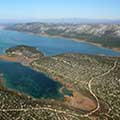
The Vrana lake is the largest natural lake in Croatia. It is actually a karst field filled with water and a rare example of cryptodepression. In the park up to now about 235 bird species were registered, of which 102 nesting birds (mainly waterfowl birds), while to the others the lake is a resting place during migration or a wintering place. According to estimates in the park during the autumn moving between 20,000 and 200,000 birds reside daily. A special feature of the park is also a wealth of fish and developed sport fishing tourism. The dominant feature of the park is a special ornithological reserve, of almost untouched natural habitat of water birds, rare wetland system, high biodiversity, of outstanding scientific and ecological value..